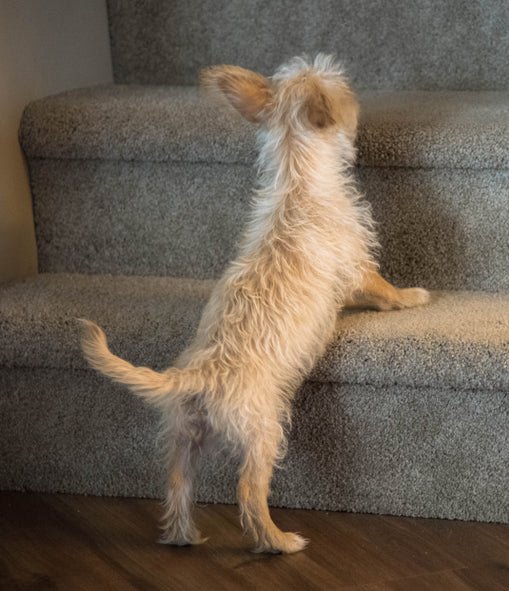We've decided to add a new series to the McCann Dogs blog! Each post in this series will start with "How to Safely Teach your Pup to Navigate: _______"
What are we Teaching Today: Stairs!
Today, we're going to talk about stairs. Stairs can be a piece of cake for some pups in terms of confidence, but those pups might be a challenge when it comes to safety. Pups who are more cautious by nature might take some further convincing to take stairs with confidence. Basically, all pups will benefit from a slow and deliberate introduction to stairs.
The Traditional Advice
Often we get good advice to avoid stairs with young pups. It's definitely a good idea to prevent repetitive stairs climbing, falling and crashing with young pups. They need time for their bodies to develop and for their growth plates to close before they are exposed to repetitive stress physical stress like jogging or lots of stairs.
Throwing a toy up or down the stairs because your young pup is a retrieving fool will tire them out, but could lead to stress related injuries in the adult dog, so it's always best to keep repetitive impact to a minimum for about the first 14 - 18 months of your pup's life, but chances are, they'll have to navigate stairs during that time. Teaching them to do so safely is a great way to keep them from hurting themselves.
I like to start pups on a short set of 2 - 3 stairs first. I start this on my deck and then build on the concept. This is not necessary, but it's the easiest way to introduce stairs. If you don't have access to a short set, you can teach using a full set. There will typically be a need for more teaching on a full set regardless, but if you can have some history in place from having practised on a short set first, that will help your pup.
Now, if you can imagine being a pup at the top or bottom of a set of stairs, they've usually learned one of two things:
1 - the stairs are big and intimidating
2 - just sit at the top or bottom and someone will carry you
Often, they don't even realize walking the stairs on their own is an options since their limited experience consists of being carried. For a long time, Ned would put his paws up on the tailgate of my vehicle and look backwards at me waiting for me to lift him the rest of the way. It wasn't that he couldn't jump into the car, it was that he had learned the tactic to take to get into the car was to plunk his front feet up and wait to be lifted. Once he was old enough to do so safely, I had to teach him that he COULD jump into the car to move to that next stage in our training. What they rehearse is what they will expect to do!
So how do you introduce the full set of stairs to your pup?
One at a time, of course!!!
Introducing the Stairs
You'll want to start near the top of the stairs as this is typically the easier direction for most pups to ease into. Place your pup on the second step from the landing and put something really enticing on the landing that they'll want - food, of course is top of the list! The idea is to break the stairs down into bite sized pieces so your pup can learn how to navigate them confidently. Looking up at 12 stairs from the bottom of the well is quite intimidating, but looking up from the second stair shouldn't be troubling to most pups. They should hop up on the landing with ease and get their reward!
If you have a pup who's reluctant to move, try putting their front feet on the landing and their rear feet on the second stair. Basically, make it SUPER easy for them to succeed. When they reach the landing, they get their reward and most will barely even notice that there were stairs involved. If your pup is hesitant, repeat this step a few times with high value reward.
Now repeat, but do it from the third stair. Be sure to 'spot' them so there is no chance of an accident if they make a wrong move. If they're successful, you can continue to move them down the stairs and allow them to climb the stairs to the landing and their treat.
A Tip to Slow them Down
Around this stage, I like to drop the odd treat on a stair or two between my pup and the landing. I make it obvious that I'm doing this so the pup knows to search midway to the top. This will help them continue to navigate the stairs in a calm fashion rather than racing to the landing where the reward is. I do this in the up direction only for safety
Teaching Pups to go Down the Stairs
Even though they're the same obstacle, navigating down the stairs takes a completely different set of skills than navigating up does. When I start the down side, I use the same process, however I put less emphasis on it than I do on the up. I will do a few reps to make sure my pup is comfortable and confident, but I pretty much limit it to those few reps, unless I have a really timid puppy. The reason for this is drive. I want my pup to move down the stairs with care, not with the intention of getting to the bottom as fast as possible. Once pups understand how to move safely from one stair to the next, they typically pick up on going down the stairs with ease.
As with anything, take your time and make the process something your pup can easily progress with and you'll have a pup who confidently and safely climbs and decends the stairs with ease.
Until next time,
Happy Training!

